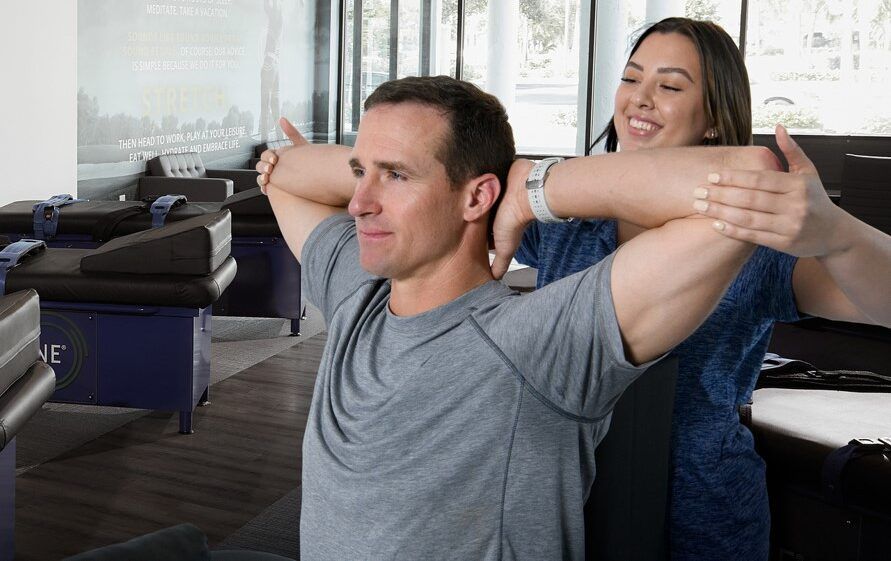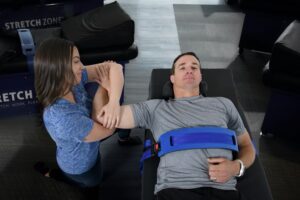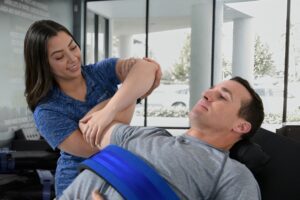We tried the Drew Brees-approved Stretch Zone method for achieving flexibility
I’ve struggled to touch my toes for as long as I can remember. Part of me wants to blame a sedentary lifestyle (Anne Lamott doesn’t call the work of writing “butt in chair” for nothing) until I remember being a 5-year-old in gym class, straining through my hamstrings while my supple-limbed rivals slammed into splits with the rubbery ease of Super Gymnast Barbie. Whatever the source of those lifelong discrepancies, they’re part of the reason why I’ve been making a conscious effort these days to limber up. Yoga helps. So do weekly classes at the barre. But when our team at inRegister heard about a Drew Brees-backed stretching studio designed to help even pro athletes perfect their resting muscle tone, we knew someone had to give it a try.
Stretch Zone, which has locations on Bluebonnet Boulevard, Jefferson Highway and Highland Road, was founded by Jorden Gold in Miami in 2004, when the idea for practitioner-assisted stretching sprouted from Gold’s experience watching his grandfather lose mobility to diabetes. These days, the company also plays a role in several philanthropic efforts, including a recent donation to Louisiana’s Kids Join the Fight nonprofit for children battling pediatric cancer. But the benefits of his stretching methodology—which eventually led to nearly 200 Stretch Zone locations and counting—reap rewards even a Super Bowl-winning quarterback could count on.
At least, that’s what I was hoping to find out during my visit.
Upon arrival at Baton Rouge’s new Bluebonnet location in the City Square shopping center, a small group of trainers—professionals with experience in fields like physical therapy or kinesiology who must first undergo a 40-hour, two-week certification course in Fort Lauderdale—hover in the airy, blue room over clients who appear to be lying on raised, cushioned beds doing … nothing. Nothing rigorous, anyway.
According to John Bladeck, a Stretch Zone representative from Fort Lauderdale’s corporate headquarters, that’s all part of the plan.
“The Stretch Zone method can be used for things like injury prevention, injury recovery or even increased blood circulation, whether that’s with people getting into health and wellness for the first time, or people looking for physical or neurological therapy,” says Bladek, referring to the trademarked technique to retrain our seatbelt-like “stretch reflex,” or our body’s neuromuscular instinct to prevent us from the harm of overextension. “It really does have a lot to do with training the mind and body together.”
Doing so requires the clients—AKA me and my stretching partner I convinced to leave home at 8 in the morning—to literally sit back and relax. Lying belly-up on my narrow bed, I answer any questions about existing pain or injuries and say to general manager Faith Ayemomba that I’d like to focus mainly on my hips and hamstrings, from which most of my problems stem. Ayemomba, a former dancer, understands completely. Even people who used to dance consistently can lose their flexibility after years of inconsistent stretching, she says, adding that Stretch Zone’s method aims to help most people reach their mobility goals within a three-month period of time.
First, though, I have to set the mobility goal, which is what Ayemomba will help me determine. Patented straps secure my torso to the bed to protect my body (and to keep me from flying off the edge) as Ayemomba assists me through various stretches dedicated to interior and exterior muscles on both sides of my body, each stretch cycling through my interpretation of the company’s 3-5-7 scale. At the sensation of a mild stretch, I call out “three.” A medium stretch, “five.” And a deep stretch, “seven.” Clients should let their assistant know when a stretch begins to move into the pain zone, past a typical 7, at which point their stretch reflex will engage and create the potential for injury.
View this post on Instagram
“A lot of people think they’ll get results faster by throwing themselves into a stretch and testing their limits,” says Bladeck, “but the opposite is true. You have to take your time, and you shouldn’t force yourself into any movement that feels worse than a nice, deep stretch.”
After the 30-minute session loosening up my hamstrings, back, shoulders and a few interior muscles whose existence I hardly knew about before, I learn that my right side tends to be significantly more flexible than my left, but also that my upper body seems to be able to move through stretches with ease, unlike my aforementioned hips and hamstrings, which could use some more work to comfortably achieve the various 90-degree angle positions Stretch Zone likes to set as a base-level goal. Ayemomba helps me return to a seated position and monitors me as I walk to and from the front of the studio, checking for any dizziness, but I feel great. Most importantly, I feel like I’ve learned something new.
So take that, kindergarten gym class. There’s a new Barbie on the block.
For more information, visit stretchzone.com.














